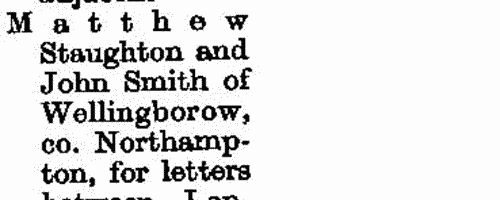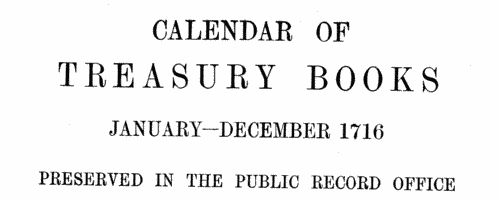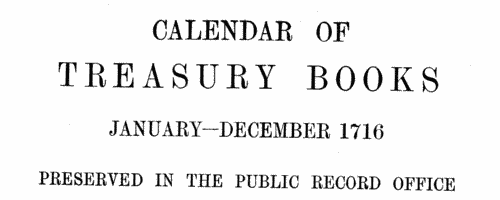Our indexes include entries for the spelling blanc. In the period you have requested, we have the following 89 records (displaying 11 to 20):
Treasury and Customs Officials, Officers and Pensioners
(1711)
Government accounts, with details of income and expenditure in Britain, America and the colonies
| Sample scan, click to enlarge

|
 Masters of Apprentices registered at Edinburgh
(1710-1712) Masters of Apprentices registered at Edinburgh
(1710-1712)
Apprenticeship indentures and clerks' articles were subject to a 6d or 12d per pound stamp duty: the registers of the payments usually give the master's trade, address, and occupation, and the apprentice's father's name and address, as well as details of the date and length of the apprenticeship. There are central registers for collections of the stamp duty in London, as well as returns from collectors in the provinces. There was a single collection for the whole of Scotland, made in Edinburgh. The sums collected are recorded in Scottish money, with conversion to sterling for transfer to London. A Scottish pund was worth 20 English pence. May 1710 to January 1712. (The sample entry shown on this scan is taken from a Shropshire return) | Sample scan, click to enlarge

|
Treasury and Customs Officials, Officers and Pensioners
(1714)
Government accounts, with details of income and expenditure in Britain, America and the colonies
| Sample scan, click to enlarge

|
Army Pensions
(1715-1716)
Abstract of the Treasury declared accounts for the Army, Guards and Garrisons and Land Forces, 17 October 1715 to 24 December 1716: E 351/103. The names of officers receiving pensions and allowances. | Sample scan, click to enlarge

|
Pensions granted by the King
(1715-1716)
Abstract of the Treasury declared accounts for the pensions and allowances granted by the King as part of the Civil List, mainly (though not all) by the Great Establishment of 18 April 1716. 15 December 1715 to 20 December 1716. AO 1/1924/13. | Sample scan, click to enlarge

|
Treasury and Customs Officials, Officers and Pensioners
(1717)
Government accounts, with details of income and expenditure in Britain, America and the colonies
| Sample scan, click to enlarge

|
 Masters and Apprentices
(1720) Masters and Apprentices
(1720)
Apprenticeship indentures and clerks' articles were subject to a 6d or 12d per pound stamp duty: the registers of the payments usually give the master's trade, address, and occupation, and the apprentice's father's name and address, as well as details of the date and length of the apprenticeship. 1 January to 3 September 1720. | Sample scan, click to enlarge

|
 Masters of clerks and apprentices
(1762) Masters of clerks and apprentices
(1762)
Apprenticeship indentures and clerks' articles were subject to a 6d or 12d per pound stamp duty (late payment of the 6d rate attracted double duty (D D) of 12d): the registers of the payments usually give the master's trade, address, and occupation, and the apprentice's name, as well as details of the date and length of the apprenticeship. 1 January to 31 December 1762. | Sample scan, click to enlarge

|
London Merchants
(1767)
The Universal Pocket Companion of 1767 contained, among 'many other necessary and entertaining particulars' this directory of London merchants. | Sample scan, click to enlarge

|
 Apprentices
(1770) Apprentices
(1770)
Apprenticeship indentures and clerks' articles were subject to a 6d or 12d per pound stamp duty (late payment of the 6d rate attracted double duty (D D) of 12d): the registers of the payments usually give the master's trade, address, and occupation, and the apprentice's name, as well as details of the date and length of the apprenticeship. 2 January to 31 December 1770. | Sample scan, click to enlarge

|
Research your ancestry, family history, genealogy and one-name study by direct access to original records and archives indexed by surname.












